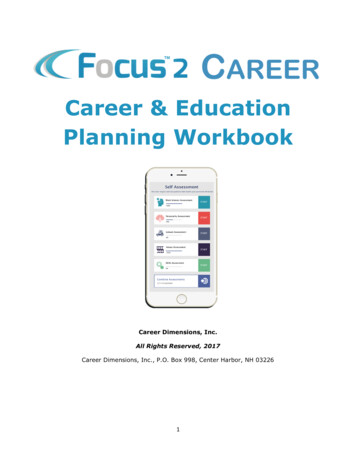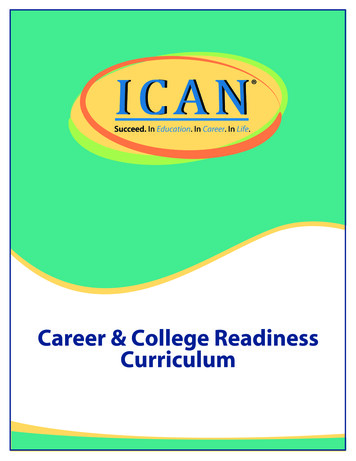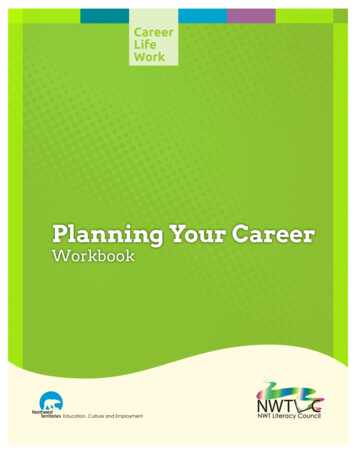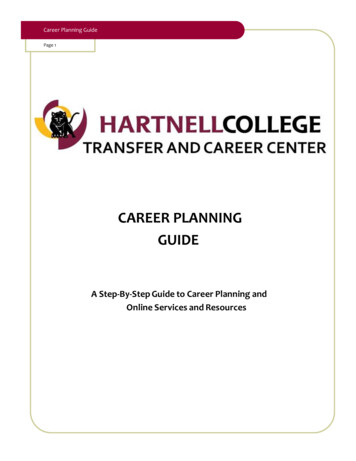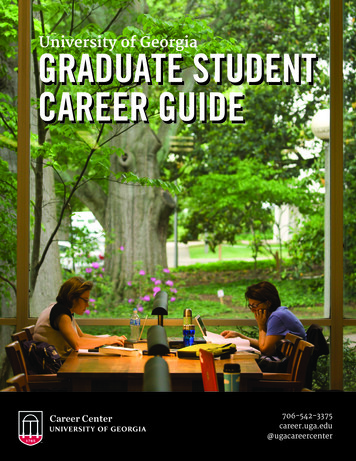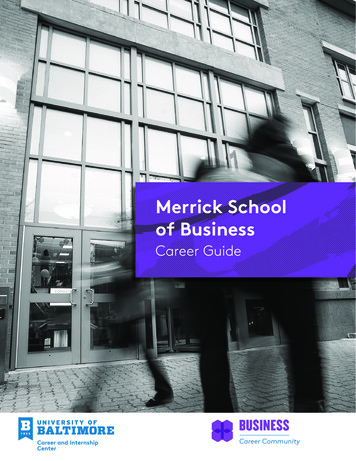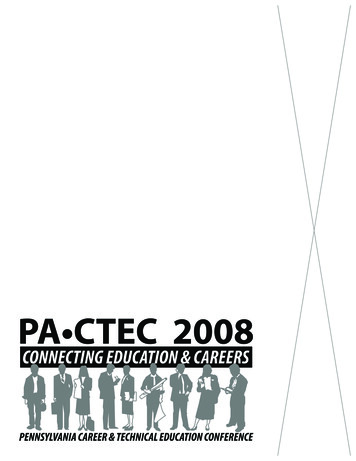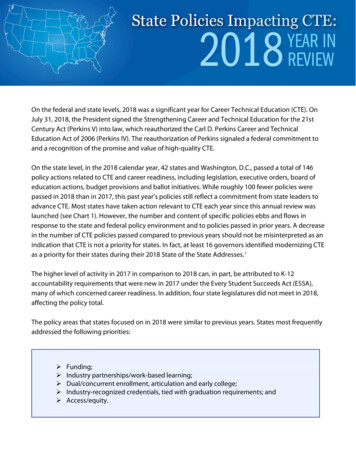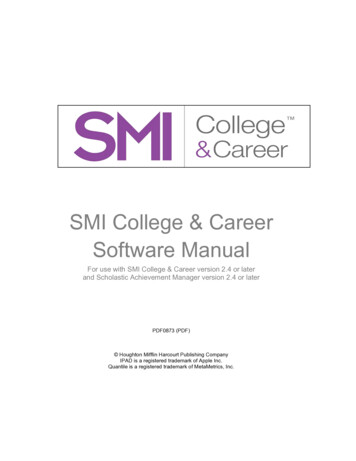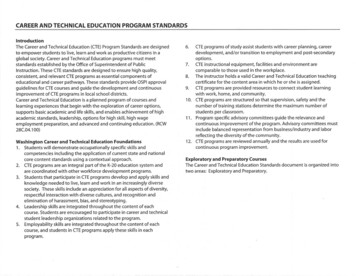
Transcription
CAREER AND TECHNICAL EDUCATION PROGRAM STANDARDSIntroductionThe Career and Technical Education (CTE) Program Standards are designedto empower students to live, learn and work as productive citizens in aglobal society. Career and Technical Education programs must meetstandards established by the Office of Superintendent of PublicInstruction. These CTE standards are designed to ensure high quality,consistent, and relevant CTE programs as essential components ofeducational and career pathways. These standards provide OSPI approvalguidelines for CTE courses and guide the development and continuousimprovement of CTE programs in local school districts.Career and Technical Education is a planned program of courses andlearning experiences that begin with the exploration of career options,supports basic academic and life skills, and enables achievement of highacademic standards, leadership, options for high skill, high wageemployment preparation, and advanced and continuing education. (RCW28C.04.1 00)Washington Career and Technical Education Foundations1. Students will demonstrate occupationally specific skills andcompetencies including the application of current state and nationalcore content standards using a contextual approach.2. CTE programs are an integral part of the K-20 education system andare coordinated with other workforce development programs.3. Students that participate in CTE programs develop and apply skills andknowledge needed to live, learn and work in an increasingly diversesociety. These skills include an appreciation for all aspects of diversity,respectful interaction with diverse cultures, and recognition andelimination of harassment, bias, and stereotyping.4. Leadership skills are integrated throughout the content of eachcourse. Students are encouraged to participate in career and technicalstudent leadership organizations related to the program.5. Employability skills are integrated throughout the content of eachcourse, and students in CTE programs apply these skills in eachprogram.6.CTE programs of study assist students with career planning, careerdevelopment, and/or transition to employment and post-secondaryoptions.7. CTE instructional equipment, facilities and environment arecomparable to those used in the workplace.8. The instructor holds a valid Career and Technical Education teachingcertificate for the content area in which he or she is assigned.9. CTE programs are provided resources to connect student learningwith work, home, and community.10. CTE programs are structured so that supervision, safety and thenumber of training stations determine the maximum number ofstudents per classroom.11. Program specific advisory committees guide the relevance andcontinuous improvement of the program. Advisory committees mustinclude balanced representation from business/industry and laborreflecting the diversity of the community.12. CTE programs are reviewed annually and the results are used forcontinuous program improvement.Exploratory and Preparatory CoursesThe Career and Technical Education Standards document is organized intotwo areas: Exploratory and Preparatory.
CAREER AND TECHNICAL EDUCATION PROGRAM STANDARDS- ExploratoryExploratory courses will meet the following regulations:1. Demonstrate application of the state and national core content standards in the context.of preparing for living, learning and working.2.3.4.1.1 Each CTE course will apply and contextualize state and national core content standards.Demonstrate foundational and career cluster specific skills required to meet current industry or nationally defined standards.2.1 Each CTE course will teach to current industry or nationally defined standards, as evidenced in the curriculum frameworks, endorsed by localprogram specific advisory committees, and approved by the CTE program supervisors at OSPI.2.2 CTE courses will incorporate curriculum focused on the interrelationships of family, career, and community roles and responsibilities.2.3 Each CTE course will include extended learning into the, community/family, and business/industry. Extended learning is managed and supervisedby certified CTE teachers.2.4 CTE courses must be taught by a certified CTE teacher with appropriate certification, knowledge, skills and occupational experience.2.4.a After initial certification and five years of teaching, certified CTE teachers should gain additional experience in one or more of the jobs orcareers in their teaching area. This experience should take place every five years.2.5 Each CTE course will provide safe and appropriate environments that support CTE program standards.2.5.a Laboratories and equipment are appropriate to and support the OSPI approved curriculum framework and industry training procedures.2.5.b Facilities and equipment meet or exceed the related federal, state and county safety standards.2.5.c Learning and training stations are of sufficient quantity to assure safe and appropriate supervision, delivery of instruction and student skilldevelopment.2.6 Curriculum is based on occupational needs and is developed and maintained in consultation with program specific advisory committees.Demonstrate knowledge of career options within the related career clusters.3.1 Curriculum related to foundational knowledge and skills of a broad range of career options in a related program of study.3.1.a These learning experiences include exploration of traditional and nontraditional careers in the program of study ranging from entry toprofessional level positions.Demonstrate leadership skills and employability skills.4.1 Leadership and employability skill development for all students is a required and integral component of all CTE courses.4.1.a These leadership and employability skills are identified in the CTE Core Leadership Skills document, the CTE Core Employability Skillsdocument and/or 2P1 Century Skills document.4.1.b All students demonstrate leadership and employability skills integrated in the approved curriculum framework and applied in real-worldfamily, community, business/industry applications.4.1.c These skills are developed and practiced at the highest professional level through integration of aligned state-recognized Career andTechnical Student Organizations (CTSOs).4.1.d Locally developed leadership plans must demonstrate that these skills are developed and practiced at the highest level through classroomintegration of individual, group and community programs and activities.
CAREER ATECHNICAL EDUCATION PROGRAM STANDARDS- PreparatPreparatory courses expand upon exploratory course characteristics in specific and complex ways as regulated below:1. Demonstrate industry indentified competencies while integrating state and national core standards comprised of a sequenced progression of multiplecourses that are technically intensive and rigorous.1.1 Current industry defined standards, as evidenced in the curriculum frameworks, endorsed by a local advisory committee, and approved by the GEprogram supervisors at OSPI.1.1.a The level of competency is defined by industry or national standards.1.1.b In the absence of national or state standards, locally developed, industry-defined standards will be validated by program-specific advisorycommittee.1.1.c Aligns with post-secondary education allowing for articulated credit, where applicable.1.2 Curriculum based on identified need and developed and maintained in consultation with program specific advisory committees.1.3 Safe and appropriate environments that support GE standards.1.3.q Facilities and equipment meet or exceed the related federal, state and county safety standards.1.3.b Laboratories and equipment meet industry training standards and facility safety standards.1.3.c Learning and training stations are of sufficient quantity to assure safe and appropriate supervision, delivery of instruction and student skilldevelopment.1.4 Certified GE teachers with appropriate certification, knowledge, skills and occupational experience.1.4.a After initial certification and five years of teaching, certified GE teachers should gain additional experience in one or more of the jobs orcareers in their teaching area. This experience should take place every five years.1.5 Extended learning into the community.1.5.a Extended learning is managed and/or supervised by certified GE teachers.1.6 Assessment of student competency of knowledge and skills as determined by industry defined standards.1.7 Instruction that develops an understanding of all aspects of an industry associated with a specific GE course.1.8 Work-based learning opportunities as identified in the Washington State work-based learning document.1.9 Instruction leads to state/nationally recognized industry assessment or certification necessary for employment or job advancement in that fieldand/or articulated college credit leading to post-secondary education.2. Demonstrate leadership skills and employability skills.2.1 Leadership and employability skill development for all students is a required and integral component of all GE courses.2.1.a These leadership and employability skills are identified in the GE Core Leadership Skills document, GE Core Employability Skills documentand/or 21'1 Century Skills document.2.1.b These leadership and employability skills are integrated in the approved curriculum framework and applied in real-world family, community,business and industry applications.2.1.c These skills are developed and practiced at the highest professional level through integration of aligned state-recognized Career andTechnical Student Organizations (GSOs).2.1.d Locally developed leadership plans must demonstrate that these skills are developed and practiced at the highest level through classroomintegration of individual, group and community programs and activities.3. Demonstrate employment readiness and/or preparation for postsecondary options using state and local programs of study, including;3.1 Information about post-secondary education, training options, industry certifications, and employment.3.2 Articulation with apprenticeship programs and post-secondary education, where feasible.3.3 Opportunities for nontraditional and special populations to receive training.3.4 The utilization of data from student follow-up surveys to improve courses.3.5 The utilization of current national, state or regional labor market information to demonstrate occupational need.
GLOSSARY OF TERMSAdvisory Committee- A committee whose members should representbusiness and industry, education, labor organizations, special populations,community, government, students, parents and teachers. A majority ofthese members shall share a working knowledge of the job tasks andcompetencies required for related occupations, related labor marketneeds and courses necessary to meet these needs. The committeeprovides advice in the design, development, delivery, evaluation andcontinuous improvement of Career and Technical Education programs.The committee meets on a regular basis and minutes are on file in thedistrict. It is the local district's responsibility to effectively informcommittee members of Washington State Career and Technical EducationProgram Standards and the Federal Perkins Act. (This definition is alignedwith the Perkins Act, Washington State RCW28C.04.1 00 and RCW28A.150.500 as adopted by Washington state.) General Advisory Committee- provides direction and guidanceto administrators and governing boards for the entire Careerand Technical Education program offered by a district orinstitution. Program Specific Advisory Committee- provides direction andguidance to administrators and teachers for a specific Careerand Technical Education program offered by a district orinstitution.All Aspects of Industry- All aspects of the industry or industry sector,including planning, management, finances, technical and productionskills, underlying principles of technology, labor and community issues,health and safety issues and work environment issues.Apprenticeship - Relationships between an employer and employeeduring which the worker, or apprentice, learns an occupation in aregistered program sponsored jointly by employers and labor unionsor operated by a plant, employers, and employee associations.Training programs are required to have a paid on-the-job workexperience and related classroom instruction.Career and Technical Education (CTE)- A planned program of coursesand learning experiences that begins with exploration of career options,supports basic academic and life skills and enables achievement of highacademic standards, leadership options for high skill, high wageemployment preparation, and advanced and continuing education.Career and Technical Student Organization (CTSO) -A WashingtonState recognized organization for individuals enrolled in a Career andTechnical Education program that engages in CTE leadership skilldevelopment activities as an integral part of the instructional program.For additional information, please refer to the Washington CTE CoreLeadership Skills document.(See Appendix A)Career Cluster- A national model for the grouping of occupations andbroad industries based on commonalities. The sixteen career clustersprovide an organizing tool for schools, small learning communities, skillcenters, academies, and magnet schools. Students will use these modelsto explore educational options that lead to employment.Career Concentrator- A secondary student who has enrolled intwo or more CTE courses above the exploratory level in a singlecareer cluster.Articulated College Credit- Courses offered at the secondary level thathave been aligned to postsecondary courses in which students receivecollege credit, such as Tech Prep, College in the High School, AdvancedPlacement, International Baccalaureate, and Running Start.Certified CTE Teacher- A teacher that holds a CTE teachingcertificate in an approved content area as documented by workexperience and education endorsements. (See OSPI Certificationrequirements)Course Equivalency- Full or partial academic credit is earned when aCTE course or sequence of CTE courses satisfies one or more academicsubject areas required for graduation.CTE Teaching Certificate- A document from OS PI designating CTEcertification.
Curriculum Framework- Approved curriculum frameworks identify therequired components of a CTE course. The components are PerformanceAssessments, Industry Defined Standards, Essential Academic LearningRequirements and Grade Level Expectations, Learning Standards,Performance Expectations, Thinking Skills, Leadership Skills,Employability Skills and Relevance to Work.Employability Skills- These skills are defined as 21st Century Skills(Appendix B)Employment- The work in which one is engaged.Essential Academic Learning Requirements (EALRs), Grade LevelExpectations (GLEs), and Performance Expectations (PE)- Statewideacademic standards for reading, writing, communication, mathematics,science, history, geography, civics, economics, arts, and health & fitness.These standards represent the specific academic skills and knowledgestudents will be required to meet in the classroom.Exploratory Courses- CTE courses in which students demonstrate theapplication of EALRs, GLEs, and PEs in the context of preparing for living,learning and working; demonstrate foundational and occupationalspecific skills required to meet current industry standards; explore anddemonstrate knowledge of career options within the related careercluster; and demonstrate leadership and employability skills.Extended Learning- Learning and teaching activities related to careerand technical education course or program competencies which occurbeyond the scheduled school day and/or school year under thesupervision of a certified CTE teacher.High Demand Occupation- An occupation with a substantial numberof current or projected employment opportunities as identified by local,state, and/or federal entities who provide occupational demand analysis.High Demand Program- A CTE program that prepares students foreither a high employer program of study or a high demand occupation.High Employer Demand Program of Study- an apprenticeship or anundergraduate or graduate certificate or degree program in which thenumber of students per year prepared for employment for in-stateprograms is substantially fewer than the number of projected jobopenings per year in that field either statewide or in a sub state region .Identified Occupational Need- Career and technical educationprograms will ensure academic rigor; align with the state's educationreform requirements and; helps address the skills gap of Washington'seconomy as validated by a CTE advisory committee.Industry Defined Standards- Standards that specify the knowledge,skills and competencies required to perform successfully in theworkplace. These standards define the technical content of CTE coursesas defined in the OSPI/CTE model curriculum frameworks. In the absenceof industry defined skill standards developed at the national or statelevel, local advisory committee validation will be required.Leadership Skills- The ability to preside, guide or manage self, others,activities or events with responsibility for the final outcome. All studentswill demonstrate leadership skills in real-world, family, community, andbusiness and industry settings. For further information, please see theWashington CTE Core Leadership Skills document. (Appendix A)Nontraditional Training and Employment- Occupations or fields ofwork in which individuals from one gender comprise less than 25 percentof the individuals employed in each occupation or field of work.Occupational Specific Skills- Technical competencies and skillstandards unique to a specific occupation that are required for successfulworkplace performance.Pre-Apprenticeship- A program that prepares individuals to applyand enter an apprenticeship program.Preparatory Courses- A technically intensive and rigorous CTEcourse or sequence of courses in which students demonstratemastery of occupational specific skills including the application ofEALRs and GLEs as required to meet industry defined standardsneeded for a specific career; leads to a certificate or credential
necessary for employment or offers dual credit; and leads toworkforce entry, approved apprenticeships, or postsecondaryeducation in a related field.Program- A sequence of CTE courses and related learningexperiences that is based on identified nontraditional, state, andregional employment needs that prepare students for responsibleroles in employment, family community and continuing education.Program Completer- A secondary student who has completed aCTE instructional programProgram of Study- A coordinated, non-duplicative progression ofcourses that align secondary education with post-secondaryeducation to adequately prepare students to enter into postsecondary education, an apprenticeship, and/or employment.Special Populations- The term 'special populations' means: individuals with disabilities; individuals from economically disadvantaged families, includingfoster children; individuals preparing for nontraditional training andemployment; single parents, including single pregnant women; displaced homemakers; and individuals with other barriers to educational achievement,including individuals with limited English proficiency.Student Leadership Development- An integral part of the CTEinstructional program; the process that enables students to fullyutilize the subject matter content they receive through the Career &Technical Education program. Leadership skills empower eachstudent to assume responsible roles in family, community, andbusiness and industry environments. Through state recognizedCTSOs, students have leadership skill development opportunitiesavailable at the local, state, national, and international level.Worksite Learning document- Learning experiences that connectknowledge and skills obtained in the classroom to those neededoutside the classroom, and comprise a range of activities andinstructional strategies designed to assist students in developing orfulfilling their education plans. For additional information, pleaserefer to the OSPI Work-site Learning document.Workplace- Anywhere work is done.
2.4 CTE courses must be taught by a certified CTE teacher with appropriate certification, knowledge, skills and occupational experience. 2.4.a After initial certification and five years of teaching, certified CTE teachers should gain additional experience in one or more of the jobs or careers in their teaching area.
